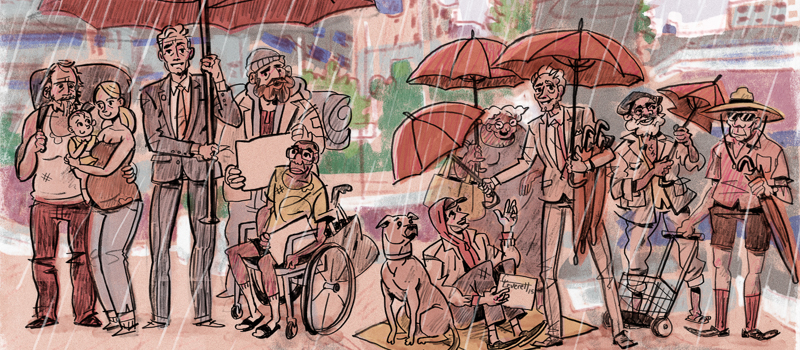For more than two years, Sarasota city and county officials have worked to solve the problem of chronic homelessness only to find themselves at a philosophical impasse.While county officials have championed the opening of a shelter that takes in all homeless people regardless of sobriety or past history, the city has been focused on dispersed housing so the homeless get a roof over their heads but do not all end up concentrated in one already-blighted area. As officials work to break an impasse and find a way to marry the programs, we spoke with the foundation that originally brought consultant Robert Marbut to town to champion a shelter and the man city officials have tasked with getting a Housing First project off the ground.

ILLUSTRATION BY CHRIS LEVERETT.
JON THAXTON, SENIOR VICE PRESIDENT OF COMMUNITY INVESTMENT, GULF COAST COMMUNITY FOUNDATION
Contrary to how it may appear, there has been important progress made in the City of Sarasota’s and Sarasota County’s understanding of our community-wide homelessness issue and what to do about it.
At their joint meeting on November 6, commissioners from each side acknowledged that both an emergency homeless shelter and a rehousing program known as Housing First are needed to combat the persistent and growing problem of homelessness in our community. Additionally, it was agreed that both initiatives would work better if they were coordinated with one another. These agreements are significant, and both commissions deserve credit.
The joint meeting also revealed that both governments were much farther along in implementing their respective homelessness initiatives than was previously known. The County, which has been advocating for an emergency shelter, has identified potential sites to locate a shelter and begun the necessary financial planning to fund both the construction and operational phases of one. The City has made significant progress in aligning community partners and possible funding strategies to launch the Housing First initiative it has been advocating for. Once again, both commissions are to be commended for their progress.
But the meeting also showed there are still outstanding differences, such as the final size and location of an emergency shelter and the County’s role in funding Housing First.
Both commissions also agreed to a 30-day period for staff to look for ways to resolve the conflicts associated with synchronizing the Housing First program with an emergency shelter. Typically, timelines or deadlines are effective in getting stalled programs activated. However, in this case, the activation has already begun and much progress has been made on both the City’s and the County’s respective programs. A deadline is not only unnecessary, it may prove to be more divisive than unifying. And it is unlikely that the outstanding differences will be resolved by stalling the implementation of the two initiatives. Both commissions wisely noted that the homeless need safe housing sooner rather than later.
Housing First and an emergency shelter have many common needs. Both require the collaborative integration of the many agencies that provide services to the homeless. Both initiatives will need case managers and a coordinated master case-management system to coordinate homeless services. Both will need mental health and substance abuse counselors. And both will require financial planning coaches, an integrated computer tracking system and employment training services. Coordinating these elements of housing and sheltering programs along the path of implementation will not only be obvious, it will be unavoidable.
The realigned direction should be viewed as an opportunity, not an obstruction to intergovernmental collaboration. The community’s proven successful homeless children and families initiative is proof of how well Sarasota County and its municipal governments can and do work together. That initiative also had many setbacks, disagreements and missteps. Only in activating our homeless families initiative, there were not reporters or cameras there to publicize every mistake.
It is critical that we move beyond the present setback and keep our eye on the goal of providing help to those in our community without safe and secure housing. Regrettably, this current “homeless debate” has caused us to focus intensely on secondary homeless services, and we’ve missed addressing two of the principal cause of homelessness: mental health issues and lack of affordable housing. Sarasota County and the City of Sarasota both have a demand for affordable housing that far exceeds their respective inventories. Mental health services and housing, affordable to our low-wage workforce and fixed-income seniors, is where we should be spending our social capital, not debating shelters, Housing First or other such symptomatic conditions. –
DOUGLAS LOGAN, DIRECTOR OF THE INITIATIVE ON CHRONIC HOMELESS, CITY OF SARASOTA
For the past year, the community conversation as it relates to the problem of homelessness has been locked in an either-or set of alternatives. Sarasota County, following the philosophic principles of consultant Dr. Robert Marbut, insists the only viable solution is a large public shelter, run by law enforcement and located “close to existing services,” which means in a poor, fragile neighborhood. The City of Sarasota, adopting the tenets of noted practitioner Dr. Sam Tsemberis, has aligned itself with a solution that emphasizes Housing First, a 20-year-old pathway that has achieved success in over 100 markets. This program only requires a modest-sized triage entry point.
The rhetoric has been heated. Each side has accused the other of intransigence. Some shelter backers have bashed the city’s alternative as a knee-jerk liberal giveaway, providing subsidized “free” housing to those who have not earned it. And some Housing First advocates think large shelter devotees are incarceration-obsessed and do not accept the science behind a more modern intervention. Positions have become fixed; parties to the fray are wedded to the righteousness of their cause; polarization rules the day.
Ironically, both sides are right. And both sides are wrong. This community cannot properly function much longer without the availability of a public shelter. Our Police and Sheriff Departments need a facility to deal with street homelessness humanely. We need this asset as an adjunct to law enforcement and if we do not provide a shelter of our own volition, we will be forced into it by the judicial system. Additionally, any system created to house the homeless requires an entry point, a place where individual needs can be assessed and treatment can be customized.
The questions, however, are ones of scale, location and governance. Unfortunately the county’s plan to combine homelessness and jail/arrest diversion in a 250-bed facility has given its proposed facility a “heavy” footprint. Instead of the impact of a ballerina that a 30- to 50-bed triage unit would have, the proposed 250-bed shelter/jail would thud on a neighborhood like an elephant’s foot. And without a clear pathway out of a shelter to Permanent Supported Housing, the shelter merely becomes a warehouse where some may get needed short-term services but the ultimate solution to homelessness, a home, is not provided.
Some have shortsightedly suggested the solution is simple: county does the shelter and city does housing. “Do your own thing.” This would be a horrible and wasteful proposition in this era of finite fiscal resources. A shelter of the scale that the county is proposing will cost in the vicinity of $10 million to acquire, construct and equip, and in excess of $4 million per year to operate. Even after making that significant public investment, a shelter’s residents will still be homeless. A Housing First program to house a meaningful number of the chronic unsheltered homeless in Sarasota could cost from $20 million to $30 million in the next five years.
To embark on those independent paths would be to squander dear resources. The truth is that we need a coordinated plan that is embraced by all political bodies. Both need to work together to implement an appropriate shelter; both need to work together on a muscular plan to develop not only the needed PSH units for the chronic homeless but also work-force, affordable housing to prevent at-risk individuals from becoming homeless. And to achieve this necessary teamwork in tackling this problem we need our institutions to set aside their ideological rigidity, talk to each other civilly, and find common ground.
Finally, an appropriate shelter and a muscular housing program are only two of the three necessary weapons we need to combat homelessness. Until we find a better way to address the issue of mental illness with an improved strategy, greater resources and better science, we will continue to experience those unfortunate sick souls subsisting in our public byways. City and county need to put together an effective “working group” to begin immediately to formulate responses to our current needs. We have too long ignored this epidemic occurring in our streets and homes.
I am fond of something Nelson Mandela used to say: “If you want to travel fast, travel alone. If you want to travel far, travel together.” This race to reduce homelessness is not a sprint. We are going to have to travel far and we have to travel together.










